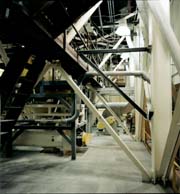Field Reports: Flour mill sees the light

SANITATION IS A PRIMARY CONCERN AT ALL General Mills processing facilities. In its 80-year-old flour milling plant in Kansas City, adequate lighting had become an issue in keeping up with the company’s high sanitation standards. General Mills signature products such as Gold Medal flour and Bisquick baking mix are made in the Missouri plant.
When the re-enforced concrete facility was constructed, it was illuminated with an incandescent lighting system with glass globes. These fixtures were removed for sanitary reasons and replaced with luminaires with plastic reflectors. Over the years, the plant experienced problems with the plastic melting, which led to retrofitting the units with Bantam 2000® luminaires from Holophane.
“We considered a number of lighting systems from other manufacturers and decided against them because many were constructed with flat surfaces and nooks and crannies where the flour could potentially accumulate,” said Robert McClellan, electrical team leader for the General Mills plant. “The Bantam luminaires are enclosed and have curving surfaces that prevent the flour from adhering to them.”
Bantam luminaires with an Enduralume® acrylic lens and 175-watt metal halide lamps were installed in the processing areas on all eight floors within the plant and in the stairwells. The fixtures were mounted on hooks installed from 10 to 15 feet above the concrete floor—depending upon the ceiling height—and spaced 15 feet on center.
“At the start of this project, our goal was to double the light levels,” said McClellan. “By installing the Bantam luminaires, we gained significantly higher footcandle levels using less than half the number of fixtures we had originally planned to install. Employees love the new lighting system because they can see so much better to do their jobs.”
McClellan said that the metal halide lamps were specified because of the illumination they provide and their color rendering capabilities. Employees inspect the milled product to assure that it is white. Any tinge to the light—such as the yellowish color provided by high-pressure sodium lamps—could detract from their ability to determine the flour’s color.
Vantage® Food Grade Luminaires from Holophane were installed above the packaging operations, which are located on raised platforms. Ductwork and piping crisscross the ceiling in these areas and are used to transport product. Flour tends to collect on the outside of the piping and must be removed by maintenance personnel who inspect the lines.
The Vantage luminaires supply 15 percent uplight, which not only illuminates the ductwork and piping for cleaning and inspection, but promotes visibility throughout the area. Like the Bantam 2000 units, the Vantage units have no nooks, crannies, ledges, latches or fins that attract the flour.
“The Holophane luminaires have provided us with high levels of visibility and the flexibility we needed throughout the plant,” said McClellan. “Even though the fixtures have been installed for a short period of time, we expect them to require very little maintenance.” u
For more information:
Jim Pacocha, 740-345-9631, jpacocha@holophane.com; www.holophane.com
Looking for a reprint of this article?
From high-res PDFs to custom plaques, order your copy today!



